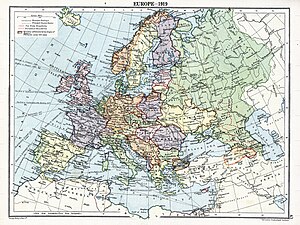Dissolution of the Russian Empire
Appearance
This article possibly contains original research. (June 2024) |
| Part of the World War I and the Revolutions of 1917–1923 | |
 Map of Europe in 1919 | |
| Date | 8 March 1917 – 30 December 1922 (5 years, 9 month, and 22 days) |
|---|---|
| Location | All-Russian Empire
|
| Participants |
|
| Outcome |
|
The Russian Empire, also known as Russia, disintegrated as the result of the Russian Revolution which started in 1917 and the abdication of Nicholas II, and the defeat of Russia in World War I. The Russian Civil War began shortly after the Bolsheviks seized power in October 1917.
The revolution erupted from widespread dissatisfaction with Tsar Nicholas II's autocratic rule and was worsened by economic hardships and social inequalities. Nicholas II abdicated in March 1917, leading to the establishment of a provisional government that struggled to maintain control amidst ongoing unrest.
Amidst the situation, numerous regions and ethnic groups within the empire declared their independence;
- Independence of Finland
- Heimosodat
- Second Polish Republic
- Ukraine after the Russian Revolution
- Estonian War of Independence
- Latvian War of Independence
- Lithuanian Wars of Independence
- Georgian Independence
- Declaration of Independence of Armenia (1918)
- Declaration of Independence of Azerbaijan
See also
Further reading
- Edmund A. Walsh. "The Fall of the Russian Empire: The End of the Monarchy". www.theatlantic.com. (FEBRUARY 1928 ISSUE) ISBN 9781494097554
- Philip Longworth. "Russia's Empires Their Rise and Fall: from Prehistory to Putin". John Murray, 2005 ISBN 9780719562044
- Pavel Miliukov. "The Russian Revolution". Academic Press, 1978
